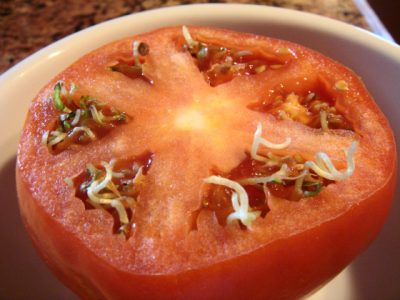Nick Goltz, DPM, UConn Home & Garden Education Center, UConn Plant Diagnostic Lab

UConn Home and Garden Education Center alum Carol Quish wrote a short blog post about vivipary in 2014 that, over a decade later, is still one of our most-read pieces. Why are folks still interested to read this post after so much time? Because seeing seed vivipary in a tomato you’re about to eat is just so darn weird. To better discuss and understand vivipary however, we should start with a little refresher on seed biology.
Reflecting back on 4th period science class with Mr. So-and-so, you’ll recall that producing a seed is both a distribution and reproduction strategy for plants. Generally, a seed is composed of a developing young plant called an embryo and a nutritious tissue to support the embryo called an endosperm, both of which are encapsulated within a hard seed coat. When an embryo is triggered to begin growing and breaks through the seed coat, many people consider this the stage of germination.
A seed will typically be in a state of dormancy while within the fruit and for a period after fruit harvest and dispersal. This strategy of undergoing dormancy is usually advantageous to the seed so it does not germinate and begin growing under adverse conditions, such as the beginning of winter or before being eaten by a hungry critter. A delicate combination of environmental cues and plant hormones maintain – and break – seed dormancy. When temperature, light, moisture, and other environmental conditions are right for that seed, hormones like gibberellin (GA) and abscisic acid (ABA) will shift in balance and germination will occur. Dormancy is typically maintained when levels of ABA are higher than levels of GA, and is broken when levels of GA are higher than levels of ABA.
When germination occurs while the seed is still within or attached to tissue of the parent plant, this is considered vivipary. Appropriately, the word “vivipary” is Latin for “live birth”. Vivipary is an essential strategy for some plants, such as mangrove trees, to increase likelihood of reaching a safe place to grow. For most plants however, vivipary is considered a physiological disorder or otherwise undesirable outcome as it decreases likelihood for successful establishment and growth, post-germination. Some highly-domesticated plants, like tomatoes, peppers, strawberries, wheat, and corn, are more prone to vivipary than others.
Seed germination within an overripe tomato. Photo credit: J. Copes.
While there isn’t uniform consensus on what combination of factors trigger vivipary, promoting high ABA levels in seeds while they’re still in the parent plant will certainly lower the odds. While there is nothing that can be done to change the genetics of the tomato on your counter, you can take steps to minimize the environmental triggers that would decrease ABA levels. Minimizing free moisture, preventing excessively cool temperatures, and drying, consuming, or processing the seed before the fruit bearing it become overripe are important strategies.
For tomatoes specifically, be sure to harvest them before they are fully ripe! Overripe tomatoes are much more likely to experience vivipary. For the same reason, whether buying or growing your own vine-ripened tomatoes, it’s important to consume them quickly. Furthermore, be sure to store your tomatoes at room temperature and not in the fridge. Not only will they be more likely to have a mealy texture when you eat them, but low temperatures may also increase the likelihood of vivipary.
The next time you happen to take a bite of a tomato filled with seeds that have experienced vivipary, don’t fret! The taste and texture may not be what you were expecting, but they’re perfectly harmless. That said, a better destination for a viviparous tomato may be your garden bed rather than your caprese salad! Seeds that have germinated within the fruit will still grow and eventually produce fruit like any other tomato seedling.
If you have questions about growing tomatoes, or any other gardening topic, call the UConn Home & Garden Education Center (toll-free) at (877) 486-6271. You can also email us at ladybug@uconn.edu, visit our website, www.homegarden.cahnr.uconn.edu, or visit your local UConn Cooperative Extension center.
This article was published in the Hartford Courant and The Westerly Sun May 24, 2025